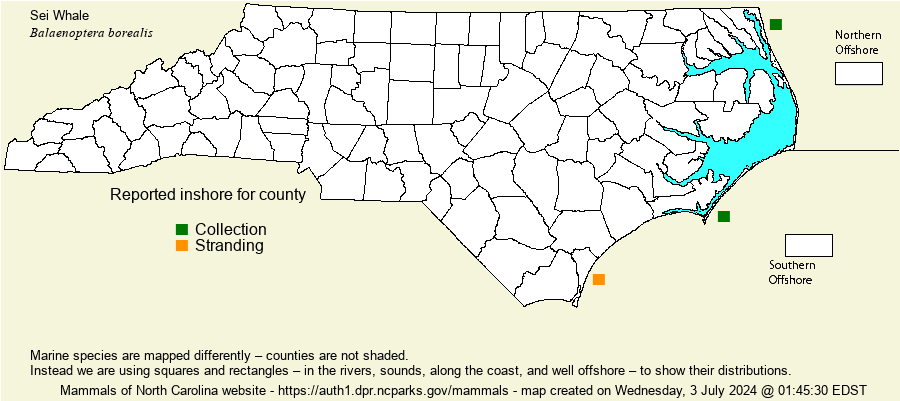|
| Distribution |
In NC, occurs sparingly offshore, but is seldom seen. There are stranding records for only three of the eight coastal counties.
Occurs in oceans worldwide, thus throughout the western Atlantic Ocean. |
| Abundance |
Certainly very rare, with only a few records. There are just three known stranding records, on 16 April 1975 (Currituck County); on 29 March 2014 (Smithsonian National Museum of Natural History database, 2016; Carteret County); and on 6 January 2019. Apparently not conclusively identified offshore in NC waters, though certainly must occur as a rare migrant. |
| Seasonal Occurrence |
Poorly known, as there are only a few state records. It migrates southward in the fall, and northward in spring; thus, it possibly is most likely to be seen in NC waters in spring and fall. Both NC strandings are in the spring season. |
| Habitat |
Deeper waters offshore; practically never seen from boats on single-day trips from the NC coast -- either because of their great rarity or because of the distance from shore (or both). |
| Behavior |
This is another very fast-swimming whale species. Unlike most other baleen whales, the tail flukes are seldom seen when the species surfaces and then dives. |
| Comments |
This whale species can be difficult to identify from the Bryde's Whale, mainly as the latter species was described only several decades ago. Also, at a distance, it can be difficult to separate from the Fin Whale (if the head and jaw coloration cannot be seen). Even so, both the Sei Whale and the Bryde's Whales are very rarely seen in the central and southern Atlantic states. The common name can be pronounced two ways, with the preference being "say", and secondarily as "sigh". As with most Balaenoptera whales, it is listed as Endangered by the U.S. Fish and Wildlife Service. |
| Origin |
Native |
| NC List |
Official |
 State Rank State Rank |
S1M |
| State Status |
|
 Global Rank Global Rank |
G3 |
| Federal Status |
E |
| subspecies |
|
| other_comName |
|
| synonym |
|


